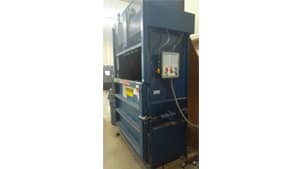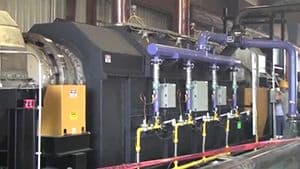Municipal Biosolids Processing

Benefits of Drying Biosolids
Working with municipal biosolids is often considered a "dirty job" that few want to dig their hands into. However, each municipality must consider how they will dispose of municipal biosolids created by the population in their area. Due to increasingly changing regulations, rising costs of landfill disposal, and many landfill depositories being landlocked, biosolids disposal is quickly becoming a leech for funds, causing municipalities to begin looking for disposal alternatives. One such solution is found within thermal drying technology, allowing municipal biosolids to be appropriately processed into Class A PFRP biosolids, that can be resold or reutilized.
As the challenge of disposing of Class B biosolids becomes increasingly more complicated, many wastewater treatment plants are searching for cost-effective solutions that will allow them to meet the more stringent EPA regulations being enforced in many areas. Vulcan® Drying Systems has developed the BIO-PRILL, an easy-to-operate, all-in-one solution that will enable municipalities to produce a valuable end-product that can be applied in many different agricultural areas.
Under 40 CFR, part 503, the United States Environmental Protection Agency (EPA) has published regulations for technologies to further reduce pathogens in municipal biosolids. The result of the new regulations is a product classified as Class A biosolids. These biosolids are safe for land application without the negative environmental effects associated with Class B material or the negative publicity received from odors emanating from land application of wet fertilizer slurry.
Vulcan® Drying Systems designed the BIO-PRILL biosolids drying unit with the intent to address the needs of the small to medium-size municipalities. The continuous operation and automated controls ensure that operators can continue to focus on plant operation with minimal interaction with the dryer. All operating parameters are under the control of a PLC system and are capable of being monitored remotely.
The BIO-PRILL is effective in drying a variety of sludges including digested and waste activated sludges. The unique design of the BIO-PRILL includes all the necessary features to produce a consistent and uniform end-product. With the ability to control the feed rate into the dryer, the residence time in the dryer, and the temperature of the air entering the dryer, the BIO-PRILL continually and efficiently produces a valuable 90%+ dry solid material.
The heat energy for drying comes through direct contact with preheated air. By lowering the dew point of the material within the drum, the BIO-PRILL is able to dry at low temperatures (~200°F). Shaker screens separate discharged solids into three sizes: overs, ideals, and fines, with overs and fines being crushed and recirculated back to the front of the system. A cooling screw assures that ideally sized material is cooled to an acceptable temperature for client supplied discharge handling equipment. An integrated cyclone and venturi scrubber remove and capture any particulate prior to vapors being released to the atmosphere.
All this adds up to a cleaner, safer, and more efficient choice for your treatment plant. To find out more about the BIO-PRILL, please download our brochure and contact us HERE.
The BIO-PRILL: Modular Class A Biosolids Dryer
Process Description
Dewatered biosolids are introduced through a wet material feed hopper 1 and mixed with dry biosolids in batch mixers 2. A proper ratio of thoroughly mixed materials entering the dryer 3 ensures the consistency required to efficiently reduce moisture and to optimize the formation of Class "A" PFRP dry biosolids. Mixed material is conveyed through the dryer where the heat removes excess moisture and reduces pathogens. Proprietary biosolids dryer technology ensures a uniform and consistent ≥90% dry solids end product. Processed material leaves the dryer through a knock out box 4 and is carried to a screen shaker 5 where it is processed to a uniform size. Any material that is too small is sent back to the dry material hopper 6. Material that is too large is processed through a crusher 7 and used as starter feed for new feed stock. The size-accepted biosolid fertilizer prills are conveyed through a cooling screw 8 and emptied in a client supplied storage container. Particulate and dust from the vapor stream is collected and removed by triple cyclones 9. The captured particulates from the triple cyclones are transferred via a drag conveyor 10 back to the dry material feed hopper 6. The vapor stream from the triple cyclones goes through a venturi scrubber 11 and inertial separator 12 to remove any residual particulate from the vent stream.
Process Capabilities
| % Solids | 14% | 15% | 16% | 17% | 18% | 19% | 20% | 21% | 22% | 24% | 26% | 28% | 30% |
|---|---|---|---|---|---|---|---|---|---|---|---|---|---|
| Feed Rate (T/Hr) | 7.6 | 7.7 | 7.8 | 7.9 | 8.0 | 8.1 | 8.2 | 8.3 | 8.5 | 8.7 | 9.0 | 9.2 | 9.5 |
| Fertilizer Produced (T/Hr) | 1.2 | 1.3 | 1.4 | 1.5 | 1.6 | 1.7 | 1.8 | 1.9 | 2.0 | 2.3 | 2.6 | 2.8 | 3.1 |
| ~ Btu/Lb Feed | 1206 | 1190 | 1175 | 1160 | 1144 | 1129 | 1113 | 1098 | 1082 | 1051 | 1020 | 989 | 959 |
Large and inconsistently sized biosolids have limited use as fertilizer as they are impossible to apply with modern, precision fertilizer application equipment.
The prill size of top choice organic (see below, far right) is very uniform and similar in size to common commercial fertilizers so that it can be applied with equipment that farmers and horticulturists already use. This uniformity also allows top choice organic to be blended in mixes with other commercial fertilizers to meet very specific soil fertility requirements.




Learn More

Vulcan® Drying Systems
Manufacturing Marvels

Cram-A-Lot
DB 60 LU Vertical Baler



